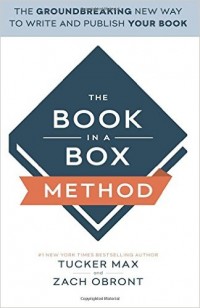Title: The Book In A Box Method: The Groundbreaking New Way To Write and Publish Your Book
Authors: Tucker Max & Zach Obront
Publisher: Lioncrest Publishing
ISBN: 978-1-61961-346-1
Pages: 270
Genre: Business Writing / Reference
Interviewed by: Gary Sorkin
About the Authors
 Tucker Max is the co-founder and CEO of Book In A Box, a company that turns book writing and publishing into a service.
Tucker Max is the co-founder and CEO of Book In A Box, a company that turns book writing and publishing into a service.
Tucker Max has written three #1 New York Times Best Sellers, which have sold over 3 million copies worldwide. He is credited with being the originator of the literary genre, “fratire,” and is only the third writer (after Malcolm Gladwell and Michael Lewis) to ever have three books on the New York Times Nonfiction Best Seller List at one time.
He co-wrote and produced the movie based on his life/book, also titled “I Hope They Serve Beer In Hell.” He was nominated to the Time Magazine 100 Most Influential List in 2009.
He received his BA from the University of Chicago in 1998, and his JD from Duke Law School in 2001. He currently lives in Austin, Texas, with his wife Veronica and son Bishop.
 Zach Obront is the co-founder of Book In A Box, a new type of publishing company focused on allowing busy experts with important messages to share to create their book without the usual barriers. Prior to Book In A Box, he ran Lioncrest Publishing and BookPop Book Marketing.
Zach Obront is the co-founder of Book In A Box, a new type of publishing company focused on allowing busy experts with important messages to share to create their book without the usual barriers. Prior to Book In A Box, he ran Lioncrest Publishing and BookPop Book Marketing.
As an expert in the changing publishing industry, he’s spoken to crowds at Harvard, Yale, Google, and Adobe, and has worked directly with hundreds of authors to professionally publish and promote their books, reaching hundreds of thousands of readers in the process.
Zach currently lives in Austin, TX, where he enjoys playing volleyball and eating the world’s best barbecue.
PBR: Today we have the honor and pleasure of speaking with two of the most creative authors and publishers in the industry, Tucker Max and Zach Obront about their new A Book In A Box Method. Welcome and congratulations on your achievement!
ZO: Thanks Gary.
PBR: So to start off, I was blown away with your technique of virtually using dictation to later be transcribed into a book. I am sure you used this method in creating this book, so who was doing the talking and which one of you were asking the questions?
TM: Of course, we had to eat our own dog food. Zach interviewed me for the book, and then he worked from the transcripts to create the first draft. At that point, I did the revisions and edits to get the book into its final form.
PBR: You guys work so smoothly together. Tell us, how did you meet and become partners on this project?
ZO: Tucker and I were both frustrated with the current state of publishing. He’d written a number of books and experienced it first hand, and I’d seen the same problems from the outside. We worked together on a few small projects to help authors we knew, but realized if we wanted to make a real impact, we needed to be able to help at a larger scale.
PBR: Your clients, or rather the authors being published using your method are extremely satisfied with their outcomes. Which of their stories were the most satisfying to you?
TM: Our first client, Melissa Gonzalez, is a perfect example of what we want for our authors. Melissa is an expert in pop-up retail, working with brands like Marc Jacobs, Chanel, and Google to create unique retail experiences. However, before her book, she was busy running her business and didn’t have the time to market herself as an expert. Her book changed all that. It became THE definitive book int he pop-up industry, and the results in her business and life have been dramatic: her incoming business leads have tripled, she’s been featured in major press like The New York Times and Bloomberg, she has her own retail-focused radio segment, and she’s now a sought after keynote speaker. You can read more about Melissa’s story here: http://bookinabox.com/melissa-gonzalez/
PBR: You make the process seem effortless, at least as compared with conventional writing techniques. What challenges did you encounter in defining your method?
ZO: The biggest challenge was defining the outlining process. We’re fortunate to have incredible book developers on our team who handle the process — people like Mark Chait, ex-Executive Editor at Harper Collins. Teaching the process to non-experts required stepping back and examining what we were doing intuitively, but I think it was worthwhile. Readers tend to find the positioning and outlining sections of the book to be the most useful.
PBR: I know you clearly say your method is solely for non-fiction, but what are your thoughts on using these techniques for an author wishing to write a novel?
TM: There are certainly pieces of our process that would work for fiction, but they’d require someone who deeply understands fiction structure and writing to change some key pieces. Our focus is entirely on non-fiction for now, but I have no doubt that a parallel fiction process will be developed in the next few years.
PBR: In your first chapter, you tell the reader not to expect to have a million copies of their book sold, instead use their book as a new form of business card, resume or professional reference. This I found to be humble and absolutely on target. How has this been received by your readers who used your method? Are they expecting the huge volume of sales?
ZO: People have trouble breaking out of the paradigm that their book needs to sell millions of copies to be a success. It’s tough when we’ve all grown up in a world where the bestseller lists are the gold standard for authors to shoot for. However, when most authors realize they can make a bigger impact and earn more revenue by focusing on fewer people, their goals tend to evolve.
PBR: I see. Is there anything else you’d like to say to people starting out with their book?
TM: Just put one foot in front of the other. Our process explains everything you need to do to make your book a reality. Don’t be intimidated by the whole process. Take one step at a time and, before you know it, you’ll get there.
PBR: Very good advice. Thank you each once again for sharing your thoughts and time with us, and we wish you the best of success with all of your projects.
TM: You too.
To learn more about “The Book In A Box Method” please visit: Pacific Book Review



Follow Us